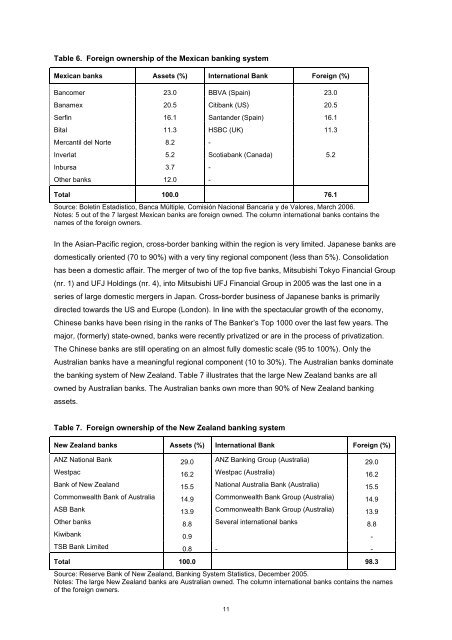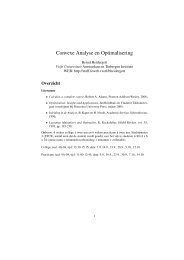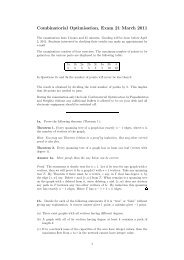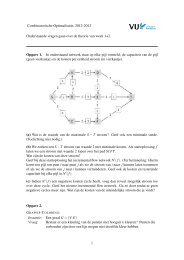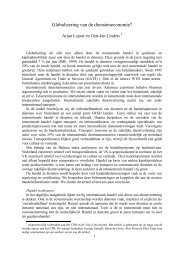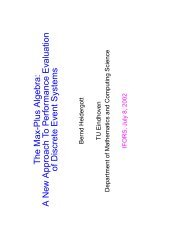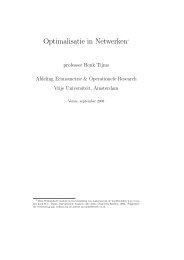Current State of Cross-Border Banking - Vrije Universiteit Amsterdam
Current State of Cross-Border Banking - Vrije Universiteit Amsterdam
Current State of Cross-Border Banking - Vrije Universiteit Amsterdam
You also want an ePaper? Increase the reach of your titles
YUMPU automatically turns print PDFs into web optimized ePapers that Google loves.
Table 6. Foreign ownership <strong>of</strong> the Mexican banking system<br />
Mexican banks Assets (%) International Bank Foreign (%)<br />
Bancomer 23.0 BBVA (Spain) 23.0<br />
Banamex 20.5 Citibank (US) 20.5<br />
Serfin 16.1 Santander (Spain) 16.1<br />
Bital 11.3 HSBC (UK) 11.3<br />
Mercantil del Norte 8.2 -<br />
Inverlat 5.2 Scotiabank (Canada) 5.2<br />
Inbursa 3.7 -<br />
Other banks 12.0 -<br />
Total 100.0 76.1<br />
Source: Boletin Estadistico, Banca Múltiple, Comisión Nacional Bancaria y de Valores, March 2006.<br />
Notes: 5 out <strong>of</strong> the 7 largest Mexican banks are foreign owned. The column international banks contains the<br />
names <strong>of</strong> the foreign owners.<br />
In the Asian-Pacific region, cross-border banking within the region is very limited. Japanese banks are<br />
domestically oriented (70 to 90%) with a very tiny regional component (less than 5%). Consolidation<br />
has been a domestic affair. The merger <strong>of</strong> two <strong>of</strong> the top five banks, Mitsubishi Tokyo Financial Group<br />
(nr. 1) and UFJ Holdings (nr. 4), into Mitsubishi UFJ Financial Group in 2005 was the last one in a<br />
series <strong>of</strong> large domestic mergers in Japan. <strong>Cross</strong>-border business <strong>of</strong> Japanese banks is primarily<br />
directed towards the US and Europe (London). In line with the spectacular growth <strong>of</strong> the economy,<br />
Chinese banks have been rising in the ranks <strong>of</strong> The Banker’s Top 1000 over the last few years. The<br />
major, (formerly) state-owned, banks were recently privatized or are in the process <strong>of</strong> privatization.<br />
The Chinese banks are still operating on an almost fully domestic scale (95 to 100%). Only the<br />
Australian banks have a meaningful regional component (10 to 30%). The Australian banks dominate<br />
the banking system <strong>of</strong> New Zealand. Table 7 illustrates that the large New Zealand banks are all<br />
owned by Australian banks. The Australian banks own more than 90% <strong>of</strong> New Zealand banking<br />
assets.<br />
Table 7. Foreign ownership <strong>of</strong> the New Zealand banking system<br />
New Zealand banks Assets (%) International Bank Foreign (%)<br />
ANZ National Bank 29.0 ANZ <strong>Banking</strong> Group (Australia) 29.0<br />
Westpac 16.2 Westpac (Australia) 16.2<br />
Bank <strong>of</strong> New Zealand 15.5 National Australia Bank (Australia) 15.5<br />
Commonwealth Bank <strong>of</strong> Australia 14.9 Commonwealth Bank Group (Australia) 14.9<br />
ASB Bank 13.9 Commonwealth Bank Group (Australia) 13.9<br />
Other banks 8.8 Several international banks 8.8<br />
Kiwibank 0.9 -<br />
TSB Bank Limited 0.8 - -<br />
Total 100.0 98.3<br />
Source: Reserve Bank <strong>of</strong> New Zealand, <strong>Banking</strong> System Statistics, December 2005.<br />
Notes: The large New Zealand banks are Australian owned. The column international banks contains the names<br />
<strong>of</strong> the foreign owners.<br />
11


